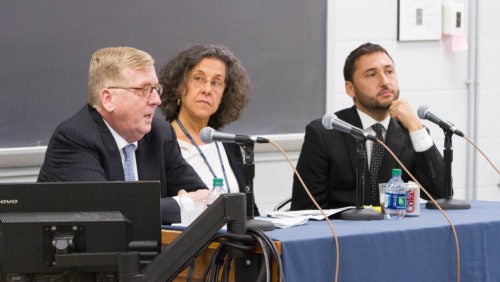Georgetown Law’s Supreme Court Institute Provides A Post-Argument Look at Gill v. Whitford
October 5, 2017

Distinguished Professor Paul M. Smith, Supreme Court Institute Director Dori Bernstein and Misha Tseytlin, solicitor general of Wisconsin, discuss the Supreme Court case of Gill v. Whitford at Georgetown Law on October 3.
Gill v. Whitford, the blockbuster gerrymandering case heard by the Supreme Court on October 3, has been making headlines ever since the Court decided to hear it. It’s a significant case, but especially so at Georgetown Law — given the three names at the top of the oral argument transcript: Misha Tseytlin (L’06), solicitor general of Wisconsin, for the appellants. Tseytlin’s Georgetown Law classmate, Erin E. Murphy (L’06), for the Wisconsin State Senate as amicus curiae. And Georgetown Law Distinguished Professor from Practice Paul M. Smith on behalf of the Wisconsin voters who challenged the map.
At a rundown of the case just hours after the oral arguments, Smith, Tseytlin and Supreme Court Director Dori Bernstein (LL.M.’89) gathered in the Law Center’s McDonough Hall to lend their thoughts. Tseytlin asserted, as he did in Court, that individual voters lacked standing to challenge the map statewide; and that the case was nonjusticiable.
“One of the points that I was trying to make is that the standard that we proposed here was similar, pretty much identical, to one that the Court had considered and rejected in the LULAC v. Perry case,” he said.
But Smith, who argued two previous Supreme Court cases on partisan gerrymandering including LULAC, is hoping that the third time will be the charm — owing to the efficiency gap, a new formula for calculating wasted votes and determining how unfair a gerrymander really is.
“The argument we made today is that this is very different from the last cases…this is justiciable now, because now we have these tools,” Smith told the students in Room 201. “We met the challenge that was laid down in Vieth v. Jubelirer by Justice Kennedy in his controlling concurring opinion…he’s still of course the target justice.”
The gerrymander at issue here was so extreme, Smith asserted, “it effectively decided who would be in charge of the Assembly in Wisconsin for ten years before a vote was [even] cast.”
Tseylin, however, disputed that claim. “This notion that gerrymandering is going to keep one party in power decade after decade, there’s really no evidence of that.”
Moot Courts at Georgetown Mean Well Prepared Advocates
Tseytlin, who mooted his argument at Georgetown Law’s Supreme Court Institute one week earlier, on September 27, had high praise for the Georgetown moot court program that allowed him to test out his argument before he went before the nine justices.
“There was not a single question that I got that I didn’t already prepare an answer for, and it was really kind of a pleasure,” he said. “I had two pages of things I wanted to say. You think about the questions you know you are going to get from the moot courts. You think, how am I going to transition, fully answering the questions of the justices, but getting to the points that I wanted? I was able to [basically] get to all of the points I wanted to convey to the justices, while answering their questions, precisely because the moot court had helped me anticipate what questions they would ask.”
Students wanted to know if anything could be gleaned from the Court’s willingness to hear the case a third time? (It was a direct appeal to the Court, the attorneys said, so it was inevitable.) And how do you craft your argument for a target audience?
“Obviously, when you are writing the brief, you try to figure out how to get to five justices,” said Smith. Regarding the argument, “We were all talking to Justice Kennedy, and he said almost nothing,” he said. “So how do we know?”